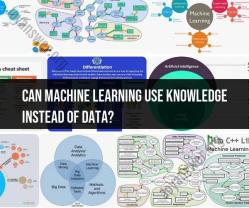How to reduce data entry errors with machine learning?
Reducing data entry errors with machine learning techniques involves automating and improving the accuracy of the data input process. Machine learning can be used to validate, correct, and enhance data as it is entered, ultimately leading to higher data quality. Here are some strategies to minimize data entry errors with machine learning:
1. Automated Data Validation:
- Implement data validation checks using machine learning models. These models can identify data that deviates from expected patterns or contains errors. For example, anomaly detection algorithms can flag unusual or erroneous entries in real-time.
2. Spell Check and Correction:
- Employ natural language processing (NLP) models to check and correct spelling errors in text fields. This is particularly useful for improving the quality of textual data entered into forms or databases.
3. Data Formatting and Standardization:
- Use machine learning models to standardize and format data consistently. For instance, ML models can ensure that dates are entered in the correct format or that phone numbers follow a consistent pattern.
4. Auto-Suggestion and Auto-Completion:
- Implement auto-suggestion and auto-completion features in data entry interfaces. Machine learning models can predict and suggest entries based on historical data or context, reducing the likelihood of typos or incorrect selections.
5. Optical Character Recognition (OCR):
- For handwritten or scanned documents, OCR technology can be combined with machine learning to convert handwritten or printed text into digital text. This helps eliminate manual data entry errors in situations where paper documents need to be digitized.
6. Data Quality Monitoring:
- Continuously monitor data quality using machine learning. Algorithms can flag inconsistencies, outliers, or potential errors in the data, allowing for timely corrections.
7. Entity Recognition and Validation:
- Use named entity recognition (NER) models to identify and validate entities within text data. For example, NER can verify that names, addresses, and product IDs are entered correctly.
8. Contextual Checks:
- Implement machine learning models that consider the context of data entry. For example, if a user is inputting medical data, the system can validate that the entered values are within medically acceptable ranges.
9. Machine Learning-Based Form Validation:
- Create machine learning models specifically trained to validate the entries in your data entry forms. These models can check for consistency, completeness, and correctness of form submissions.
10. User Feedback Loops:- Establish mechanisms for users to report errors and provide feedback. Machine learning models can use this feedback to improve their accuracy over time.
11. Regular Model Retraining:- Machine learning models can become more accurate with time and additional data. Regularly retrain your models to ensure they remain effective at catching and correcting data entry errors.
12. Error Tolerance and Alerts:- Set up error tolerance thresholds and alerts so that when data entry errors exceed a certain level, appropriate actions can be taken to investigate and correct the issues.
By implementing these machine learning techniques, organizations can significantly reduce data entry errors, improve data quality, and enhance the efficiency of data-related processes. It's important to tailor these approaches to the specific data entry challenges and requirements of your organization.
Enhancing Data Entry Accuracy with Machine Learning: Strategies and Tools
Machine learning (ML) can be used to enhance data entry accuracy in a variety of ways. Here are a few strategies and tools:
- Data validation: ML algorithms can be trained to identify and flag potential errors in data entries. This can help to prevent errors from being entered into the system in the first place.
- Data completion: ML algorithms can be used to complete missing or incomplete data entries. This can save time and effort for data entry operators, and it can also help to improve the accuracy of the data.
- Data enrichment: ML algorithms can be used to enrich data entries with additional information. For example, an ML algorithm could be used to extract a customer's location from their address. This additional information can be used to improve the accuracy of downstream tasks, such as customer segmentation and targeted marketing.
Here are a few tools that can be used to enhance data entry accuracy with machine learning:
- Data validation tools: There are a number of data validation tools available that can be used to identify and flag potential errors in data entries. These tools typically use a combination of rules-based logic and ML algorithms to detect errors.
- Data completion tools: Data completion tools can be used to complete missing or incomplete data entries. These tools typically use ML algorithms to predict the missing or incomplete values based on the other values in the data entry.
- Data enrichment tools: Data enrichment tools can be used to enrich data entries with additional information. These tools typically use ML algorithms to extract information from a variety of sources, such as public records and social media.
Minimizing Errors in Data Entry: The Role of Machine Learning
ML can play a significant role in minimizing errors in data entry. By using ML to automate data validation, completion, and enrichment tasks, organizations can reduce the number of manual errors that occur. This can lead to a significant improvement in the accuracy and quality of their data.
Data Entry Reinvented: Using Machine Learning to Reduce Mistakes
ML is helping to reinvent data entry by automating many of the tasks that are traditionally performed by humans. This is leading to significant reductions in the number of errors that occur in data entry.
In addition, ML is making data entry more efficient and productive. For example, ML-powered data entry tools can help to automate the process of capturing data from documents and other sources. This can free up data entry operators to focus on more complex tasks.
Conclusion
ML is a powerful tool that can be used to enhance data entry accuracy, minimize errors, and improve the efficiency and productivity of data entry operations. Organizations that are looking to improve their data quality and reduce their risk of errors should consider using ML-powered data entry tools and solutions.




